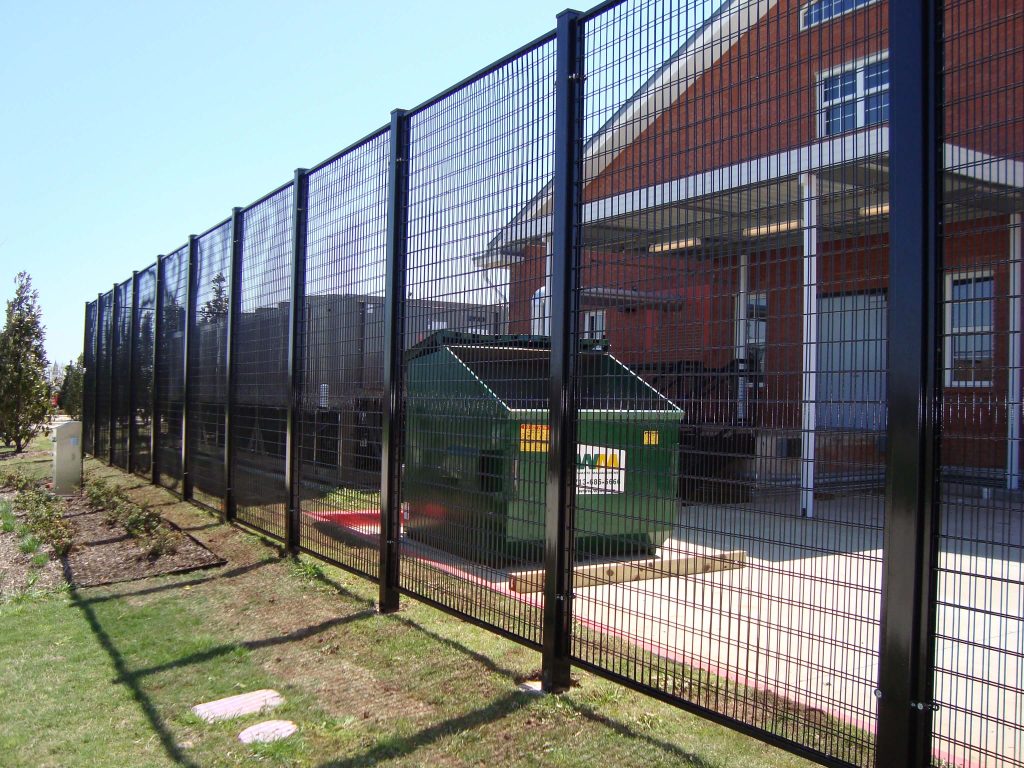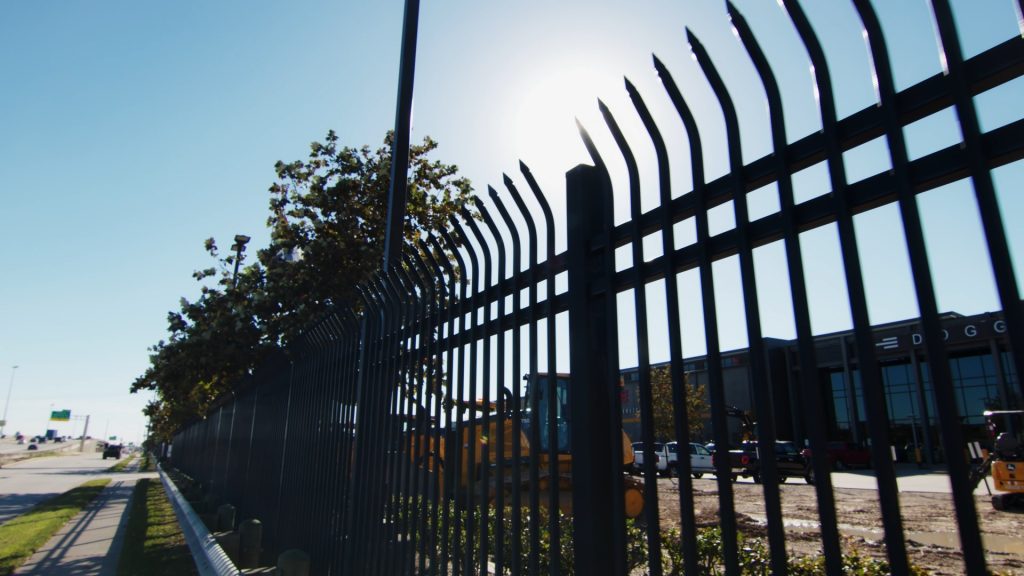How a Security Fence Can Protect Your Business
Protect Your Business with a Security Fence

Installing a security fence around your business can provide added protection from theft and vandalism, as well as creating a sense of security for your customers. Additionally, it can serve as a deterrent to potential intruders.
How Does a Security Fence Secure Your Property?
The main objective of a security fence is to secure a property, thereby preventing unauthorized access. Security fences are especially effective because they are designed to prevent people from entering without permission and provide an immediate visual cue that the area is restricted.
Security fences come in a variety of different types and materials to best suit the needs of any business. Mesh fencing is often used as it provides a physical barrier that also allows visibility, while razor wire can be installed on top of existing fencing to act as another layer of protection. Chain link fencing is also commonly used because it is strong and relatively inexpensive. No matter which type of fence is chosen, it’s essential that it be properly maintained and routinely repaired or replaced when necessary, in order to keep property secure.
It could be argued that no matter how secure a fence may seem, it’s still possible for talented thieves or trespassers to find ways around it. Additionally, due to the high costs associated with installing and maintaining security fences, businesses must weigh their need for protection against the potential value gained by using those resources elsewhere. Ultimately, though, the advantages of having a security fence in place far outweigh any drawbacks, making it an invaluable asset in keeping property safe and secure.
A security fence not only prevents burglary and vandalism but also has a deterrent effect that could help discourage any potential incidents before they occur. That’s why it’s important for businesses to carefully consider the role that security fences can play in safeguarding their investments and maximizing their profits.
Deterrent Effect
The primary role of a security fence around a business property is to provide a visual deterrent that can help stop criminals from targeting your business in the first place. In many cases, simply having a security fence – or at least the suggestion of one – can be enough to discourage potential vandals or thieves. This has been proven to be particularly effective for smaller businesses and those located in high-crime areas, where vandals and thieves tend to look for accessible targets.
On the other hand, some entrepreneurial owners may argue that being more visible in public can help with advertising and act as an attractive feature for clients. For example, making sure that merchandise is always visible from outside may increase customer engagement, and make it easier for curious customers to step into the store. Additionally, not having a fence may make it easier for customers to access the shop or establishment during open hours.
No matter which side you find yourself on, it’s important to consider what makes sense for your business specifically. When deciding whether to install a security fence around your business property, evaluate both sides carefully before reaching any conclusions.
Ultimately, security fences are designed primarily to provide protection, not only against theft but also against vandalism and other potential risks. By providing an extra layer of protection around your property, security fences can ensure that your business remains secure and protected in the long run.
Perimeter Control
As a business owner, it’s important to understand the advantages of having secure perimeter control in place for your business. Perimeter control is the practice of creating secure borders around a property and limiting access to specific individuals who have been adequately vetted or authorized to enter.
There are several benefits associated with having perimeter control in place, including increased safety and security, improved asset protection, greater operational efficiency by restricting unnecessary access, and improved customer service. This can also be an effective way to screen potential threats and deter unwanted visitors from entering your premises. Utilizing a well-maintained security fence can create that secure border and help prevent theft or trespassing, while also increasing public awareness about the site’s restricted access.
However, there are also some drawbacks associated with perimeter control. For instance, it could take up precious space on the premises; it could also increase the cost of surveillance due to its need for constant monitoring; and it has the potential to create certain privacy concerns for certain businesses.
Overall, perimeter control is an important consideration when protecting your business from theft and vandalism. By maintaining a secure border with a security fence, you can significantly reduce the risk of external threats while increasing profits by allowing only those authorized personnel inside your premises.
The next step in protecting your business is designing an access control system that limits entry points within your premises. That way, you’ll be able to monitor who has access to specific areas within your facility and better protect your assets against unauthorized entry and actions.
Designing an Access Control System
Once you have decided to install a security fence, it is important to plan an access control system. An access control system will help regulate who has access to your business’ grounds and implement strict protocol for who can enter. These controls can be designed to allow authorized personnel entrance while minimizing physical contact with the public and potential threats to the property.
Access control systems come in many sizes and complexities. First and foremost, these systems should be tailored to fit your business’ needs by deliberating the specific areas that require higher levels of security. Once these locations are identified, access control features can be implemented accordingly.
Extremely secure locations may opt for a biometric scanner which requires entry of a secure code as well as scanning of identification such as a fingerprint or retinal scan before entry is granted. Other areas may opt for simpler solutions such as a keypad with an encrypted password or a card reader. If funds allow, other features such as surveillance cameras may also be helpful in monitoring entrances and exits for maximum security.
The most important consideration when designing an access control system is if it meets the security requirements of a business without creating unnecessary difficulty for customers or staff entering the premises. The goal is to find a balance between convenience and security—a compromised system could result in unwanted consequences like break-ins, theft and vandalism, whereas an overly secure system could discourage customers from visiting your business premises in the first place.
Once you have determined which type of access control system best fits your needs and that the setup will not interfere with customer satisfaction, you can move forward in investing in a security fence that further reinforces your newly designed access control system.
Benefits to Adding a Security Fence
Security fences can offer several benefits for any business. A security fence is an obvious visual deterrent for potential intruders, and it also serves as a physical barrier that keeps those intruders out. Intruders face a tougher challenge when attempting to enter through a secure fence than other methods, such as doors and windows.
Furthermore, security fences can help to protect the business from vandalism, theft, and illegal activities. Then there are the intangible benefits – like peace of mind – knowing that your business is kept safe and secure.
Those in favor of installing security fences argue that they provide extra added protection and peace of mind. They reduce crime, protect assets, and ultimately increase profits. Furthermore, properly installed and maintained security fencing can improve the overall aesthetic appeal of a building or facility, further beautifying a neighborhood or business district.
On the other hand, some people may be opposed to adding a security fence due to the cost factor involved. The installation of security fencing might involve significant upfront costs that could be difficult to mitigate when weighed against the potential benefits. This can especially true when considering businesses located in crime-ridden areas where property damage losses are already high.
In summary, adding a security fence comes with both risk and reward for businesses to consider carefully. Before investing in a security fence, it’s important for businesses to weigh their options and determine if the cost is necessary or not once analyzed against potential return on investment estimates.

Risk Control
The purpose of risk control is to use a variety of methods to reduce the likelihood of security breaches and decrease the amount of damage caused should one occur. A security fence provides a physical layer of defense that prevents access to areas where valuable assets are located. This reduces risks in multiple ways. It makes it harder for criminals or terrorists to reach vulnerable targets and therefore decreases the likelihood of attack. It also limits the amount of damage they can cause by preventing them from stealing expensive equipment or causing costly destruction.
Evidence shows that having a security fence can be an effective way to control risk. Statistical studies have found that businesses with such fences are less likely to be burglarized than those without them. The presence of such barriers may even deter criminals, as research has shown that visibility is an important factor when considering whether or not to attempt a break-in.
Of course, there are potential drawbacks to consider as well. Installing and maintaining a security fence can be expensive, meaning some organizations may not be able to afford it or may choose not to invest in it despite understanding its benefits. Additionally, while adding a physical layer of protection can make it more difficult for attackers to gain entry, they may still find ways around or through it if they’re determined enough.
Ultimately, however, the presence of a security fence can help businesses better manage their security risks – provided the right measures are put in place, and both short-term financial costs and long-term implications are taken into account during its construction and operation. With these considerations in mind, organizations can begin integrating surveillance technology into their defense systems to protect their business and increase profits.
Surveillance
Surveillance is becoming an increasingly popular and effective way to prevent illegal entry and maintain a safe perimeter around businesses. Security cameras, such as CCTV systems, can capture footage of any person or vehicle entering and departing from the area. This footage can then be used to enhance security by deterring criminal activity and aiding law enforcement in solving crime.
No matter the size or layout of the property, surveillance systems can be tailored to meet its specific needs. Wireless options make it easy to install a comprehensive system with minimal disruption. Automated gate entry systems offer further protection by allowing entry only with predetermined credentials such as key cards, codes or even fingerprint scanners; this will further limit unauthorized access.
Arguments in favor of enhanced surveillance could include increased security and decreased potential liability; however, there are drawbacks as well. Companies must consider how much they plan to spend on a surveillance system, and whether it is within their budget. Strict privacy laws should also be taken into consideration when installing advanced cameras, as footage containing identifiable individuals may be governed and monitored accordingly.
Having the right surveillance system in place can offer an extra level of protection for businesses. However, companies should carefully weigh the pros and cons before investing in installation.
Factors to Consider Before Installing a Security Fence
Before deciding if a security fence is the right choice for your business, there are several factors to consider. Hiring a professional company to install a security fence typically requires significant financial investments. Depending on the size of the area and type of fencing material, the cost could range from hundreds to thousands of dollars. By weighing the potential benefits along with the costs, you can better determine if it’s worthwhile to make such an investment.
Aesthetics are another factor when making this decision. At first glance a security fence may appear uninviting, which could turn away potential consumers. On the other hand, having a well-designed fence that adds value to your property can increase its value and improve overall curb appeal.
The function of the fence is also critical in ensuring that it provides maximum security protection. Without proper utilization of additional deterrents such as motion detectors or specialized locks, access control systems and surveillance cameras, most fences only offer minimal protection against intruders.
Finally, consider how well maintained your fence will be over time. Proper maintenance is key in ensuring that your fences remain secure and effective in preventing unauthorized access. This includes conducting regular inspections and repairs whenever needed.
The cost, aesthetics, function, and maintenance are all important elements to consider when choosing if you should install a security fence at your business. Knowing these factors can help you decide if it is worth the investment now and in the long run to increase profits and protect your property.
Advantages and Disadvantages of a Security Fence
A security fence can offer various advantages and disadvantages when it comes to protecting a business. However, understanding the pros and cons of using a security fence will help you determine if it is the right option for your enterprise.
Advantages of Security Fences
The primary advantage of security fencing is the prevention of unauthorized entry into secure areas. Security fences act as a physical barrier, providing an extra layer of surveillance that can come with minimal investment in both time and money. Security fences help to deter criminals from entering premises and also protect assets from theft or vandalism. Furthermore, installing a secure fence can create a better working environment for employees by preventing strangers from entering on-site.
Disadvantages of Security Fences
One disadvantage to security fences is that they often restrict accessibility, which can lead to difficulty or delays when responding to emergencies. Additionally, automated systems like CCTV surveillance, access control systems and card readers may need to accompany the installation of the fence, resulting in higher costs than anticipated. Additionally, environmental effects must be taken into consideration before opting for security fencing such as noise pollution, wildlife disturbance or threats to local ecosystems.
Conclusion
When it comes to protecting your business and increasing profits, a security fence is an important line of defense. It helps protect the business’s physical assets while offering an additional layer of protection against theft by both employees and outsiders. This can translate into cost savings in the long run.
At the same time, it’s important to consider the financial cost of installing a security fence. The upfront costs may be high depending on the materials used, height of the fence, and size of the property line. Additionally, there may also be significant ongoing maintenance costs that come with having a fence installed.
Ultimately, it comes down to a decision based on each individual business’ specific needs and budget. While installing a security fence can help protect a business from outside threats and add an extra layer of security for employees, this may not be feasible for smaller businesses or those with limited budgets. However, for larger businesses that can make the investment in a secure fencing system, it can be well worth it in terms of increased safety, security measures, and potential cost savings over time.
Common Questions
Are there any other alternatives to installing a security fence?
Yes, there are other alternatives to installing a security fence. Businesses could invest in high-tech surveillance equipment such as cameras and motion detectors that alert personnel when potential threats are detected. This provides an effective way of monitoring and tracking intruders. Additionally, well-trained security guards can be hired to patrol the property and deter potential criminals. Lastly, businesses can invest in invisible electronic protection systems such as perimeter alarms to make sure that even the smallest breach is quickly identified. All these solutions will provide an extra layer of security for businesses without having to rely solely on physical fencing.
What are the costs involved with installing a security fence?
The costs involved with installing a security fence will vary depending on the size, type, and complexity of the fence. Factors such as quantity and installation complexity will also be taken into consideration. Generally speaking, a simple chain-link fence with installation can range anywhere from $2,500 to $10,000 (dependent on the amount of fencing materials used). If more complex materials are used, the price could rise even higher. The total cost may also include labor charges for installation and additional materials needed to anchor and secure the fence. Additionally, yearly maintenance fees may need to be covered in order to ensure the fence remains secure over time.
What specific security benefits does a security fence provide?
A security fence is a great way to protect your business and increase profits. It can help restrict access to certain areas, deter trespassers and potential criminals, and protect your property from unwanted visitors or intrusion. Specific security benefits include:
1. Deterrence: By putting up a barrier around the perimeter of your business, you can make it more difficult for intruders to gain access. This can help reduce the risk of theft, vandalism, and other malicious activities.
2. Visibility: Security fences provide visibility into what’s always happening outside the premises – which could be a deterrent in itself by helping to prevent any suspicious activities from taking place. This increased visibility can also help round-the-clock security personnel monitor the area more effectively.
3. Increased surveillance: Installing CCTV cameras on or near the security fencing can further boost security as they provide constant monitoring and are able to capture any trespassers in the act.
4. Improved employee safety: Security fences can help keep out those with bad intentions who might otherwise attempt to hurt employees or customers onsite.
By installing a security fence and investing in proper security measures, businesses can benefit from improved safety, decreased risk of theft, better visibility of their premises, and overall increased peace of mind.








